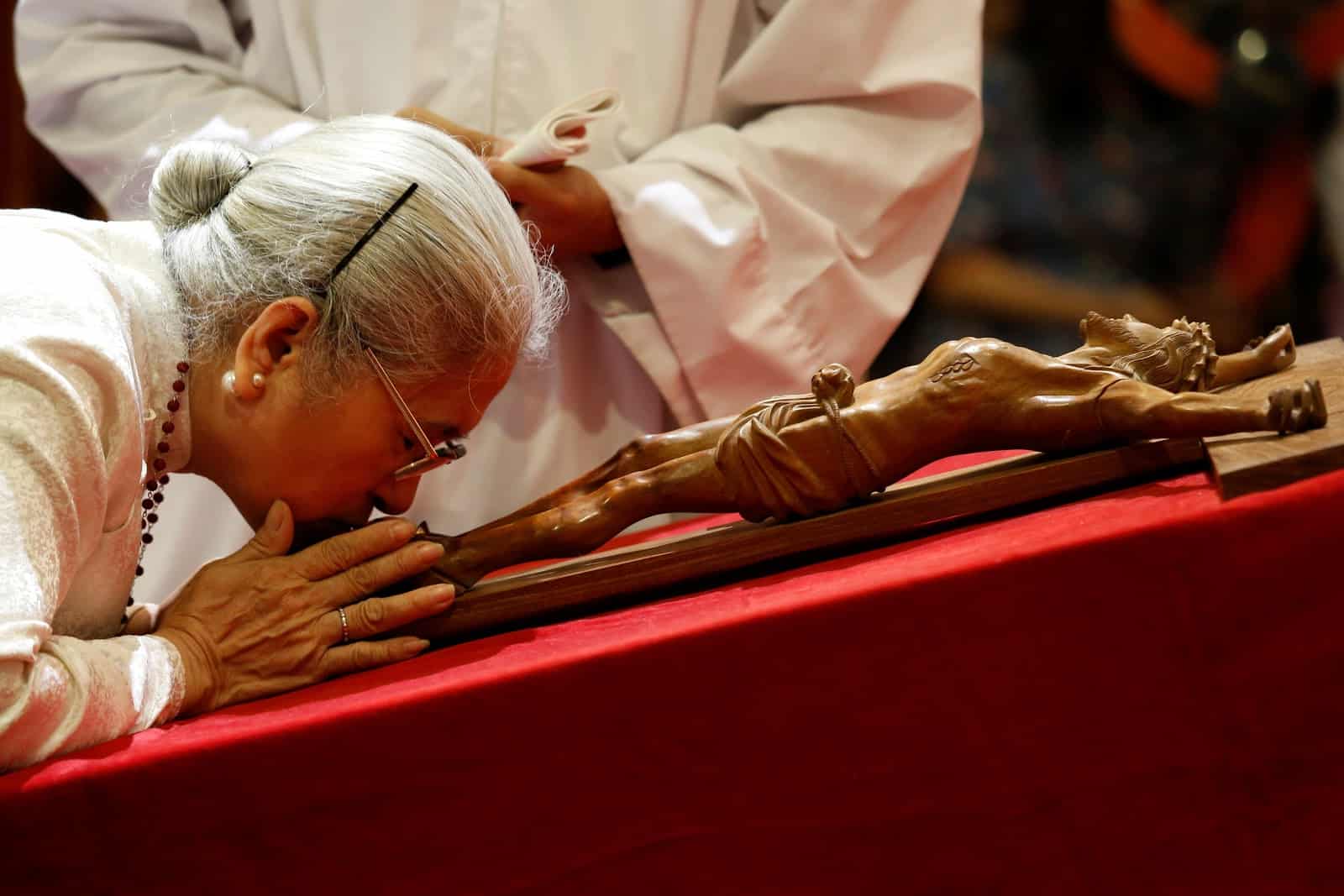About five days after I professed my first vows in the Society of Jesus, I went downstairs to the breakfast table of my community, opened the newspaper, and read about a priest who snuck into the hospital room of a seven-year old girl who was recovering from her tonsil-removal and raped her. And precisely because of his priesthood, he never suffered any jail time.
Each day, for about three weeks, I would go downstairs for breakfast and find either a story about a priest sexually and violently exploiting a child in grizzly detail or about a bishop trying to, above all, guard the image of the Church in the face of scandal. Most of the time it was both.
As the headlines keep worsening and the depths of ecclesial corruption continue to surge into the foreground, I can’t help but think of Mi Cristo Roto, a type of parable written by a Spanish-Mexican Jesuit named Ramón Cué. Living in post-civil war Spain, Cué wanders into an antique store in Sevilla and finds a crucifix that’s been desecrated during the upheaval. The corpus, the body on the crucifix, is missing its head, as well as its right arm and leg. It’s a crucifix on which Christ has been dismembered. “Only God has the full statistics of sacrificed Christs,” Cué laments, shaken at the thought of how many religious images must have been irreverently defaced if not completely ravaged.
Afterward, Cué hears the corpus talk back to him; he hears Jesus respond to his lament:
—Listen to me, why do you remember before my torn members the ones who, in the war of 1936, mutilated my images and don’t even think about remembering the many who offend, injure, exploit, and mutilate their brethren, the people, in the postwar? Which do you think is the graver sin: mutilating a wooden image that only represents me, or mutilating an image of me that’s alive, enfleshed, in which I palpitate and beat through the grace of Baptism and incorporation into the Church? You forget that all the baptized are authentic Christs and against each of them you hurt, you betray, you cause to stumble, you persecute, you hate, you crucify… Is it not worst to mutilate a living Christ than that of a wooden image? Hypocrite! You rend your vestments before the memory of the one who mutilated my wooden image while you outstretch your hand or render honor to the one who mutilates, physically or morally, the living Christs, who are your brethren.
What exactly is it that you’re mourning? That’s what Jesus asks him—and us, too. Are we lamenting the deflated image of the Church, the loss of our credibility? Or the children who have been raped and silenced?
Focusing merely on the image of the Church, it’s reputability and credibility, has suffocated the care and concern for children, the Church itself, Christ himself. That’s the lesson for us in Cué’s colloquy with Jesus.
The shock isn’t just the heart-stabbing bewilderment at how someone could rape a child. It’s also what would make someone hear what I described in the beginning of this article and respond by marshaling one’s efforts to keep scandal to a minimum.
For me there wasn’t much of an image to protect. In 2002, when the revelations about Church leaders covering-up crimes of sexual abuse shocked the world, I was eight years old. I have no memory of it as breaking news. All I can remember is growing up with movie tropes of pedophile priests or surreptitious, politically-minded cardinals. I don’t remember a time before the sex-abuse crisis. Nevertheless, reading headline after headline for weeks about the abuse cover-up ad nauseam doesn’t lessen the shock of reading just one victim’s story.
Shame, confusion, anger, betrayal, and mourning, are the only appropriate responses in the arsenal of the human heart. And they shouldn’t go to waste. I believe that the Lord wants to use all of these feelings because I believe he solicits our action by pulling on the depths of our souls. He wants to direct us. Otherwise nothing will change, and nothing will get better.
Whatever stirs in us as a response to the crisis has to lead us to prayer and action without settling for self-isolation, or outright abandonment of a community that will be at a loss if not enriched by the gifts of everyone.
So I hope you don’t stop feeling betrayed, angry, sorrowful, and disgusted. At least, I hope that these strong revulsions don’t just pass away without being acted upon. Otherwise, they can wither into a complacency for corruption, a naturalization of spiritual worldliness in our Church—our home. The people of God have the right to demand holiness of its priests and bishops.
We have to pray, grieve, fast, in such a way that ushers us into constructive engagement with our local Church. We have to act on these emotions to make them more than just emotions. Lay leaders are now, more than ever, especially needed and called to bring much needed life into the Body of Christ.
In the end, we need to always prefer and seek out the truth of the suffering body of Christ. We can go from obsessing over the image of Catholicism to tending to the wounds of the despised, rejected, and abused Jesus. And letting God stir in us what God wants will mature our worship. That’s the significance of this act by Cué:
I lifted him into my two hands and neared him to my lips. But the kiss asked me: where? What can I kiss that isn’t broken? I’ve never dared kiss a Christ on the face. Who is worthy? It seems to me to repeat the gesture of Judas who dared kiss his cheek….I kiss his hands. His wounds. Always his feet. Both of them. Because they’re always together, such that with one sole kiss, like one sole nail, it reached both his feet. But now…now he’s without his right leg; and his left foot isn’t complete, the only one they left him. That’s where my lips went. It was a new kiss, strange, uncomfortable. My lips didn’t find the known and savored mold of the feet of Christ.
My lips didn’t know how to kiss only one torn foot. Without a partner and without a nail. My mouth didn’t lull in the possession of the kiss. I got the impression that my lips were filling up with splinters and Blood. And yet, ever since I tried it, I prefer the uncomfortable and piercing kiss on the only splintered foot of my poor, broken Christ.
What would it look like if we let these terrible crimes elicit in us a tenderness that draws us nearer to Christ, which always also means drawing nearer to others? We have here an emblem of how to respond to human weakness and suffering within our response to God.
The challenge for us is to know and even prefer the splintered Christ, so that we can recognize him, as he truly is, in the suffering that’s around us and overwhelming our Church.


